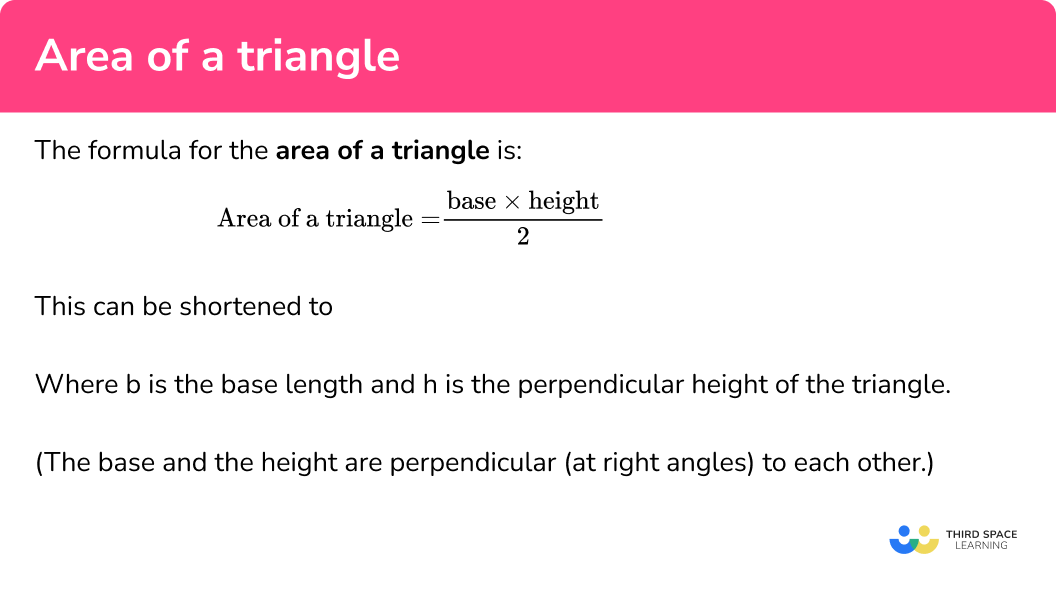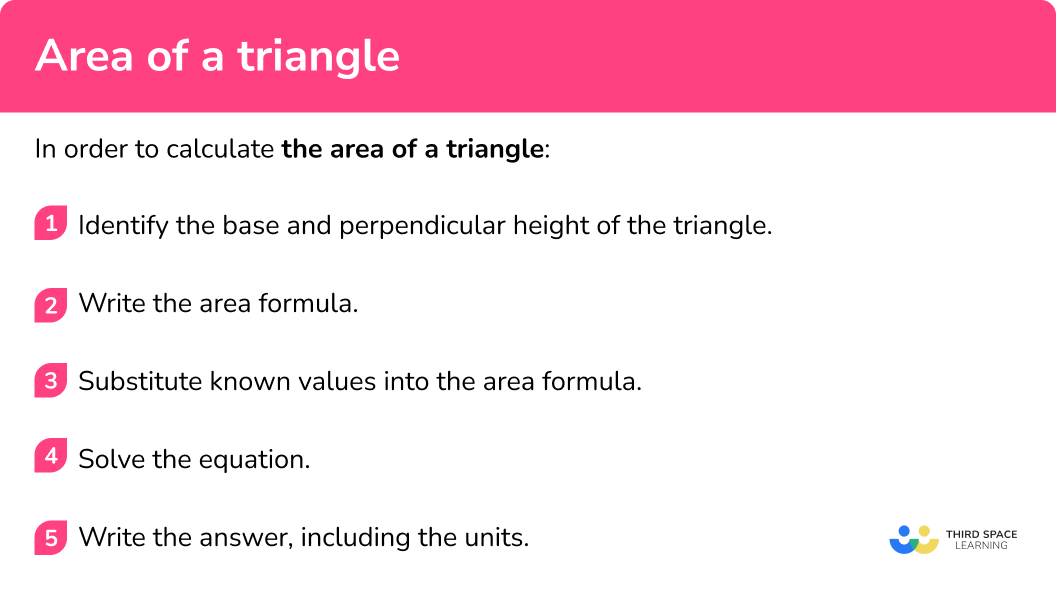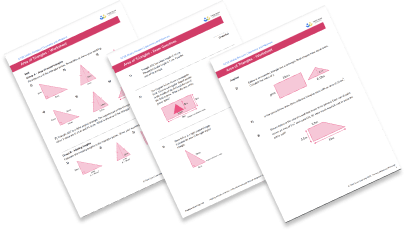One to one maths interventions built for KS4 success
Weekly online one to one GCSE maths revision lessons now available
In order to access this I need to be confident with:
Arithmetic Adding and subtracting fractions Multiplying and dividing fractions Adding and subtracting decimals Multiplying and dividing decimals Area of a rectangle Pythagoras theoremThis topic is relevant for:

Area Of A Triangle
Here we will learn about the area of a triangle, including how to find the area of a triangle with given dimensions.
There are also area of a triangle worksheets based on Edexcel, AQA and OCR exam questions, along with further guidance on where to go next if you’re still stuck.
What is the area of a triangle?
The area of a triangle is the amount of enclosed two-dimensional space that three connected straight lines take up.
In order to derive the area of a triangle, we start with the area of a rectangle.
The area of the rectangle below would be calculated by multiplying the base by the height (). This is usually pronounced as “base times height”.
We can split a rectangle into two smaller rectangles by drawing a perpendicular line through any two parallel sides of the rectangle.
Splitting these two rectangles in half by joining the diagonals together, we can create two pairs of congruent (identical) right-angled triangles.
The area of the rectangle is now halved to get the area of the triangle, so the area of the triangle is exactly half the area of the rectangle, when we know the base and the perpendicular height of the triangle.
What is the area of a triangle?

Area of a right angled triangle formula
The formula for the area of a triangle is:
This can be shortened to
where is the base length and is the perpendicular height of the triangle.
(Perpendicular means that the base and the height are at right angles to each other.)
Your final answer must be given in square units, e.g. or .
Higher – There is an alternative method to find the area of a triangle which involves sine, two sides and the included angle. This is part of trigonometry.
Step-by-step guide: Area of a triangle ( )
On this page we’ll look at the area of scalene triangles. A scalene triangle is a triangle where all of the sides and all of the angles are different.
This means that a scalene triangle can contain three acute angles, a right-angle, or one obtuse angle (and two acute angles).
Remember: All of the angles within any triangle must add up to .
Labelling triangles
The triangle below has the three sides labelled and and the three vertices labelled and The side opposes the vertex and so on.
You should also be familiar with the notation that this triangle is called triangle .
Each side could also be labelled using the capital letters that denote the start and end point of the line. For example, the side is also known as the side , the side can be referred to as side , and side can be expressed as side .
How to calculate the area of a triangle
In order to calculate the area of a triangle:
- Identify the base and perpendicular height of the triangle.
- Write the area formula.
- Substitute known values into the area formula.
- Solve the equation.
- Write the answer, including the units.
How to calculate the area of a triangle


Area of a triangle worksheet

Get your free area of a triangle worksheet of 20+ questions and answers. Includes reasoning and applied questions.
DOWNLOAD FREE
Area of a triangle worksheet

Get your free area of a triangle worksheet of 20+ questions and answers. Includes reasoning and applied questions.
DOWNLOAD FREERelated lessons on area
Area of a triangle is part of our series of lessons to support revision on area. You may find it helpful to start with the main area lesson for a summary of what to expect, or use the step by step guides below for further detail on individual topics. Other lessons in this series include:
- Area
- Area of a circle
- Area of a quadrilateral
- Area of a trapezium
- Area of a parallelogram
- Area of compound shapes
- Pi r squared
- Area of a rhombus
- Area of an isosceles triangle
- Area of an equilateral triangle
- Area of a right angled triangle
- How to work out area
- Area of a rectangle
- Area of a hexagon
- Area of a pentagon
Area of a triangle examples
Example 1: right-angled scalene triangle
Calculate the area of the right-angled triangle . Write your answer in square centimetres.
- Identify the base and perpendicular height of the triangle.
The sides AC and BC are perpendicular to each other (the angle at is a right-angle) and so we can state the values for the base and the perpendicular height of the triangle to be:
The base:
The perpendicular height:
2Write the area formula.
3Substitute known values into the area formula.
4Solve the equation.
Work out the value for by solving the equation:
5Write the answer, including the units.
Remember: Your final answer must be in square units.
Example 2: obtuse scalene triangle
For triangle , the angle at is an obtuse angle, the length , and the height of the triangle is . Calculate the area of triangle
Identify the base and perpendicular height of the triangle.
As AC is perpendicular to the height stated for the triangle, we can state:
Write the area formula.
Substitute known values into the area formula.
Solve the equation.
Solving for , we have
Write the answer, including the units.
Example 3: acute scalene triangle – mixed units
Calculate the area of triangle below. Write your answer in square metres.
Identify the base and perpendicular height of the triangle.
Currently we have different units here. We must convert them to a common unit (here we will use metres as the question requires the answer to be in square metres):
So the base and the perpendicular height of the triangle are:
Write the area formula.
Substitute known values into the area formula.
Solve the equation.
Write the answer, including the units.
Example 4: obtuse scalene triangle – too much information
is an obtuse scalene triangle. The point lies on the line such that angle .
Calculate the area of the triangle below, correct to decimal places.
Identify the base and perpendicular height of the triangle.
Here, we need to distinguish which two lengths are perpendicular to one another as we can use these as the base and the height of the triangle .
As the question states that angle , the side of the triangle is perpendicular to the length which is the height of the triangle. We therefore can state:
Write the area formula.
Substitute known values into the area formula.
Solve the equation.
Write the answer, including the units.
Example 5: compound shape
A rectangle and a triangle are placed together to make a compound shape .
Calculate the area of the compound shape to decimal places.
Identify the base and perpendicular height of the triangle.
If we split the compound shape into two polygons, we have a rectangle and a triangle.
As and are two parallel sides of a rectangle, and so we can calculate the vertical height of the triangle by subtracting from This gives us the following dimensions on the original diagram:
If we sketch another copy of the triangle and label the dimensions of it, we get:
We can now state the values for the base and perpendicular height:
Write the area formula.
Substitute known values into the area formula.
Solve the equation.
Work out the calculation
Now we must find the area of the rectangle.
Write the answer, including the units.
How to find a missing side length given the area
Sometimes a question might give you the area and ask you to work out the missing length. In order to do this you must rearrange the formula to make the missing value the subject, and then solve for this letter.
In order to find a missing length given the area:
- Write the area formula.
- Substitute the known values into the area formula.
- Rearrange the equation and solve.
- Write the answer, including the units.
Missing side length example
Example 6: calculating the base length given the area
The area of a triangle is . The height of the triangle is Find the length of the base of the triangle.
Write the area formula
Substitute the known values into the area formula
Rearrange the equation and solve.
We can solve the equation by rearranging to find the unknown
First we can tidy up the right-hand-side
Then we divide both sides by
Write the answer, including the units.
Remember: Your final answer must be in linear units only as it is a length.
Common misconceptions
- Identifying the correct information to use
The base and the height must be at a right angle to each other. They must be perpendicular. You may be given additional sides of a triangle that are not needed. You may also need to rotate the triangle around so that you can identify the base and height more easily.
- Units
It is common to forget the units for area in the final answer. When calculating area, your answer must always have units squared (or square units).
Practice area of a triangle questions
1. Calculate the area of the triangle:




The base and the perpendicular height are and respectively, so the calculation we need to do is:
The units will be
2. Find the area of the triangle. Give your answer in




The base is which needs to be converted to The height is The calculation we need to do is:
The units will be
3. Find the area of the triangle:




It may be easier to see the base and height if you turn the triangle. The base and the height are and The is not needed. So the calculation we need to do is:
The units will be
4. Triangle is an obtuse scalene triangle. The angle at . Calculate the area of the triangle. Give your answer in :




The base is which needs to be converted to The height is The calculation we need to do is:
The units will be
5. Find the area of the compound shape. Give your answer in :




The compound shape is made up of a rectangle and a triangle.
The area of the rectangle is
The area of the triangle is:
The total area will be
The units will be
6. The area of a triangle is . It has a height of . Find the base length of the triangle.




The area is and the height is The calculation we need to do is:
The units will be
Area of a triangle GCSE questions
1. A triangle has a base of and perpendicular height
Work out the area of the triangle.
(2 marks)
(1)
(1)
2. The diagram shows a triangular lawn.
A gardener wants to buy grass seed for this triangular lawn.
A packet of grass seed covers of ground.
A packets of grass seed costs
Calculate the cost of buying grass seed to cover the lawn.
(4 marks)
(1)
(1)
(1)
(1)
3. Here is a triangle and a rectangle.
The area of the rectangle is times the area of the triangle.
Work out the width of the rectangle.
(4 marks)
(1)
(1)
(1)
(1)
Learning checklist
You have now learned how to:
- Calculate the area of triangles
- Derive and apply the formula to calculate and solve problems involving area of triangles
The next lessons are
Beyond GCSE maths – Heron’s formula
The ancient Greeks used a different method for finding the area of a triangle. This is a useful method as we can work out the area of a triangle if we know the side lengths of the triangle. It is based on the semi-perimeter of the triangle (half of the perimeter).
The semi-perimeter is and the side lengths of the triangle are and
This formula is known as Heron’s formula.
Still stuck?
Prepare your KS4 students for maths GCSEs success with Third Space Learning. Weekly online one to one GCSE maths revision lessons delivered by expert maths tutors.

Find out more about our GCSE maths tuition programme.